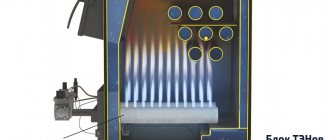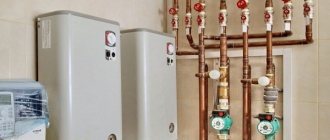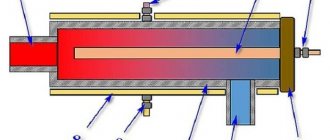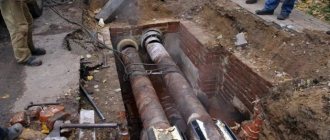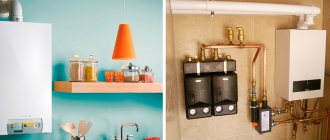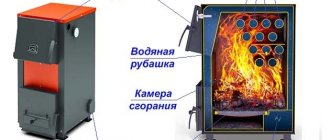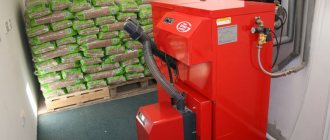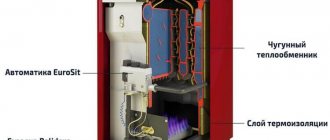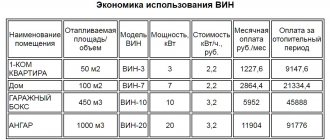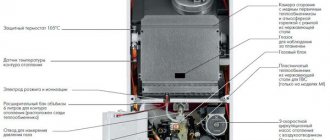Recommendations for choosing a new generation mini-automatic machine
In addition to the characteristics considered, it is worth paying attention to some more features:
- Power - calculated individually for each type of boiler. The power determines whether the heating of the room will be sufficient.
- Efficiency—for electric boilers, the efficiency factor is high—95–98%.
- Power adjustment can be stepped or smooth. In models with an independent heating element, step adjustment is used. Smooth is possible only in devices with a rheostat.
- Price depends on many indicators: type of electric boiler (heating element, ionic), power, manufacturer, additional functions.
Reference! Particular attention should also be paid to the size, weight of the electric boiler, efficiency, and the type of room it will heat.
Carrying out maintenance
It is worth noting that. Like any other heating device, electric boilers require maintenance of some components. And all this work must be carried out both at the beginning of the heating season and at its end.
The regulations for the necessary technical work include, first of all:
- Disabling the main electrical module;
- After which you should clean the module from dust and other contaminants;
- Conduct a visual inspection of all module pipelines to ensure that there are no possible leaks;
- Next, dismantle the protective plugs and check the quality of fastening of the working contacts; if a loose connection of the contacts is detected, tighten them.
That's practically all that concerns service. You can install the plugs in their standard places, connect the power to the main module, and start the system. It is also worth saying that for the most part this work is carried out by specialized organizations that sell and install these units. But as can be assessed in general, this procedure does not have any subtleties, and it can be completely done independently.
As for current repairs, its regulations will be as follows:
- The first thing to do is turn off the power to the module;
- Carry out work to clean it from dirt and dust;
- Close the system ball valves;
- Unscrew the polyamide nuts securing the electrodes;
- Clean the electrodes and the inside of the module from scale formation and blockages;
- Inspect the fastening of the contacts and, if necessary, dismantle them, clean them and install them in their normal place;
- Assess the condition of the temperature sensor;
- The final stage of work will be the sequential reassembly of all components and installation of all plugs and protections in place. Next, you need to open the system taps to provide power and start the system.
Very important: to maintain the unit in working condition and prevent premature breakdowns, maintenance of the unit must be carried out at least once a year
Electric heating element boilers GALAX
Hydraulic connection - heat-stabilized (operating temperature 95 degrees C) pipe and fittings Heisskraft ClimatFaser
Circulation pump Unipump 25×60 130 (5 year warranty)
Automation and protection - pressure gauge, safety valve, air vent and thermal fuse KSDI 90
Control and heater manufactured by JSC Firma GALAN (24 month warranty)
Climatic offers a wide range of electric boilers of various capacities. Read the information or call our consultants to choose the right boiler model.
Electric boilers are designed for heating a private house, cottage, apartment (including apartment heating)
, various administrative, commercial and industrial facilities ranging from 30 to several thousand square meters. m. Electric heating is optimal where there is no main gas or where there are strict requirements for the environmental friendliness of heating devices. Also, an electric boiler is often used as a backup heating option in case problems arise with the main boiler, for example, a gas one.
An electric heating boiler consists of a heat exchanger, a block of heating elements, a control unit and control and safety devices. Some electric boilers are equipped with a circulation pump, expansion tank, safety valve and filter. The coolant heated by electricity circulates through a system of pipes and radiators, providing space heating, as well as heating water in the boiler. An electric double-circuit boiler is used for heating and hot water supply, a single-circuit boiler is used only for heating a house, as well as for heated floors.
pros
: Compared to boilers using other types of fuel, electric boilers are cheaper, more compact, safe and silent. Connecting electric boilers is much simpler and less expensive than other types of boilers. Due to their compact size and light weight, electric boilers are wall-mounted, do not require a separate boiler room, and installation is allowed in utility or utility rooms, storerooms, kitchens, basements, and even living rooms. Electric boilers are easy to operate and do not create harmful emissions and foreign odors, do not require constant maintenance, expensive cleaning and regular fuel purchases.
Minuses
: Dependence on the stable availability of electricity and high demands on the quality and reliability of electrical wiring. You should also take into account the fairly high cost of electricity. To make an informed decision about purchasing an electric boiler, it is recommended to make a preliminary calculation of electricity costs.
The boiler will be used in the Russian climate on average from September to April inclusive, i.e. only 8, not 12 months a year. In autumn and spring, the boiler will be used at a minimum, in winter - at full capacity. Thanks to the built-in automation, the boiler will not operate continuously, on average - about 8 hours a day, so the approximate energy costs for the year can be calculated using the following formula:
240 days X 8 hours a day X boiler power X cost of 1 kW of electricity
Electric boilers with a power of up to 12 kW are available in single-phase (220 V power) and three-phase (380 V power), and boilers with a power of more than 12 kW are only three-phase. Most electric boilers with a power of more than 6 kW allow multi-stage power adjustment.
Various remote programmers that can maintain the room temperature according to a user-specified schedule help save energy without sacrificing comfort.
To select an electric boiler, you need to find out the power of the device. Basic calculation - 1 kW of boiler power is enough to heat 10 m2 of a well-insulated room with a ceiling height of up to 3 m.
To select a specific electric boiler model, you can contact the consultants of the Termomir company. Remember that in addition to the boiler itself, it is necessary to purchase other elements of a complete heating and water supply system (radiators, pipes, pumps, thermostats, boiler and much more), so it is better to entrust the selection of equipment and its complete set to professionals.
Currently, our company’s product range includes both the best electric boilers from European manufacturers and good inexpensive Russian electric boilers.
Need help choosing or haven't found the model you're looking for?
Call!
How much will it cost to buy an electric boiler?
The domestic market of heating devices is rich in models of electric boilers. There are options of both Russian and foreign production. Considering reviews of an electric boiler for heating a 220V home, we can note the fact that LINK. domestic models are more affordable in terms of cost. This is due to the fact that, as a rule, inexpensive materials are used in production. Due to this, low cost is achieved. In terms of design, Russian boilers are simpler than imported ones. But, nevertheless, these devices fully fulfill all the requirements for heating the room.
Boilers produced by foreign companies have more complex equipment. The unit turns on smoothly, which eliminates power surges. Some models have the ability to connect a thermostat. Quiet operation and a high level of safety are important advantages of imported units. Of course, the price of a 220V electric heating boiler for a cottage will be high. Therefore, such a high-tech installation will not be affordable for everyone.
It should be noted that the cost depends on a number of factors: type of installation, number of circuits, size, model, availability of additional functions, manufacturer. Prices for boilers powered by electricity are presented in a wide range. Therefore, the buyer can choose the most suitable option both in terms of technical characteristics and cost.
Of course, the cost of a particular device largely depends on its power level. So the price for a 220V 3 kW electric heating boiler will be several times lower than for more powerful devices. Additional features also make the equipment more expensive.
The cost also depends on the manufacturer. Vaillant boilers are very popular. The company specializes in single-circuit wall-mounted electric boilers of the eloBLOCK series. All products are equipped with a built-in safety group, have smooth multi-stage power level adjustment, and microprocessor control. The average price for an electric boiler for heating a 220V home is about 30,000 rubles.
Dakon boilers are also very popular. The manufacturer produces units with power from 4 to 60 kW. On average, equipment from this company costs about 50,000 rubles. EVAN company offers a wide range of electric boilers. There are budget devices in the economy and standard classes. Thus, the EPO model has a simple design and has relay control. The price is quite reasonable - about 9,700 rubles.
Domestic Evberg boilers are distinguished by good quality and reliability. The units are quite affordable. For example, an Evberg 220V 5 kW electric boiler costs approximately 15,000 rubles. This model is ideal for heating an office, home or other facility whose area does not exceed 50 sq.m.
Thus, today electric boilers are often used to heat homes. They have a number of advantages over other types of heat generators. The range of these units on the modern market is very wide.
You can choose an electric boiler option that satisfies both technical characteristics and cost.
Many people, in order to save money, try to make a heating boiler themselves. But before you make a 220V electric heating boiler with your own hands, you need to weigh the pros and cons. After all, the work will require special tools. Without special qualifications and experience, such a unit cannot be made. And the slightest mistake can lead to serious consequences. Therefore, it is better to save up money and purchase a ready-made device.
Why is a turbine needed?
Heating boilers, as a rule, have quite large dimensions. This is due to the need to obtain a large volume of oxygen needed for fuel combustion. Accordingly, to increase power it is necessary to expand the combustion chamber and air ducts. However, a turbocharged double-circuit wall-mounted gas boiler takes up quite a bit of space and is content with a very small combustion chamber. What is his secret?
In this design, air does not enter the combustion chamber naturally, but is forced under pressure. Floor-mounted and wall-mounted gas double-circuit turbo boilers use powerful fans (turbines) as a means of supplying air and removing exhaust gases. In this case, the combustion chamber itself remains closed and does not communicate with the room in which the boiler is installed. Thanks to this, turbocharged boilers not only have great power, but are also absolutely safe.
Boilers with a closed combustion chamber must be installed close enough to an external wall to ensure adequate air flow. If this is not possible, large-diameter pipes are used to supply air, but they should not be long. Experts indicate that the optimal length of the air duct is up to 3 meters.
Important! When installing a turbocharged boiler, it is necessary to provide high-quality protection from wind, which can significantly change the characteristics of the air flow inside the combustion chamber. In addition, it is desirable to prevent moisture from the ambient air from entering the combustion chamber
Advantages of buying electric boilers
For heating a dacha, 220 volt electric boilers are the best choice.
All that is needed to start using this equipment is to simply plug it into the network. Units of this type have many advantages over other heating devices. So an electric boiler for heating a 220V house is characterized by:
- High efficiency. As a rule, this figure exceeds 95%.
- Easy to install. There is no need to create a boiler room. This significantly simplifies the installation process and reduces financial costs.
- Silence. During operation, the unit makes virtually no noise.
- Reliable to use.
- Easy to use. The unit does not require constant maintenance. Therefore, problems such as the need for regular cleaning or replacement of nozzles do not arise.
- Minimum operating costs. Since electric boilers for heating a private house 220 volts do not require the cost of delivery and storage of fuel.
- Possibility of working in reserve. Electric boilers can function together with other heating equipment. Therefore, they can be used as a backup heat source.
- Compactness. Many wall-mounted boiler options are small in size. Floor-standing models are also quite compact. Therefore, there is no need to allocate a separate room to house the heat generator.
- Safety and environmental friendliness. During operation, a 220V electric heating boiler does not emit harmful combustion products. Therefore, a chimney is not needed.
- Availability of additional features. Some models are equipped with a step power control option. There are options with GSM remote control.
- High level of automation. The device is able to maintain the optimal temperature level in the house without outside intervention. All you need is to configure the device for a specific operating mode.
- Affordability in terms of cost: the price of an electric boiler for heating a 220V home is acceptable.
It’s true that electric boilers also have some disadvantages, for example:
- Consumption of large amounts of electricity. Therefore, by installing such a device, electricity costs will increase.
- It is not recommended to install boilers in areas with frequent power outages and power surges. Of course, you can install a voltage stabilizer and an uninterruptible power supply. But these are additional costs.
- Heating element models are somewhat difficult to operate. Scale builds up on heating elements over time. Because of this, the device begins to consume more resources.
But, despite this, the advantages of electric boilers still outweigh the disadvantages, and to a significant extent. Of course, the price of electric boilers for heating a 220V apartment is considerable. But this disadvantage is gradually compensated by the increasing cost of solid fuel and gas.
Features of energy-saving electric heating boilers
To heat a room today, a wide variety of equipment is used, which differ in functionality and other parameters.
The cheapest fuel today is gas. But not all private houses have it, while electricity is connected even in dacha settlements. That is why the electric heating energy-saving boiler is gaining popularity. The price for equipment and installation is very affordable, which is also an advantage. An electric heating system has a number of advantages:
- High level of security. When compared with units running on gas or solid fuel, the chances of emergency situations occurring are much lower.
- Ease of installation and operation.
- No additional purchase of fuel is required if electricity is supplied to the house.
- Silent option.
- There is no damage to the environment during operation.
- Various ways to adjust temperature conditions.
Thanks to such a large list of advantages and the availability of connection without additional communications, the option of an electric heating boiler is becoming increasingly popular.
Related article:
Operating principle of an electrode boiler
The boiler design provides for connection to a closed heating system. And the entire cycle of its operation is controlled using built-in automation. It is the automatic controllers that regulate the temperature of the system, which can be kept between 20 and 90 degrees.
Also, a magnetic starter, which is built into the boiler controller system, monitors the drop in operating temperature and, if necessary, turns on the heating independently. After which it will also automatically turn off the system if it reaches the desired temperature range. In turn, the electrical network will also be protected from possible overloads that occur when the boiler is turned on, accompanied by increased loads. And in this case, the boiler will be helped by an automatic circuit breaker; when critical loads on the network occur, it will turn off the boiler until it is completely stabilized. The boiler system also includes coarse filters, which will protect the electric boiler from contamination and further decommissioning.
New generation mini-automatic electric boiler
principle of operation
- It is worth saying that these units (electric mini-boilers) can be used to heat residential buildings, industrial warehouses, all kinds of industrial premises, country houses, and even greenhouses.
- It is also worth noting that these devices can work with heating systems, both with natural circulation of the working fluid and with forced circulation.
- In addition, Electric boilers can be used to prepare hot water using indirect heating boilers.
- Electric boilers can also be used in the construction of thermal curtains, for working with “warm floors”, for drying wood, in systems with combined water and electricity supply (wind generators, solar panels, centralized water supply, autonomous well with electric pump).
Mini electric heating boiler VEN-4.5 kW
One of the advantages of electric boilers is that these units can be installed in already working heating systems, in parallel with another heating device already installed (gas boilers, solid fuel boilers). In order to achieve the maximum effect from this device over large areas, it is necessary to install several such devices, thereby reducing the load on each unit separately and increasing its service life.
Unique energy-saving electric mini-automatic boiler
GAS IS 2 TIMES CHEAPER!
The mini-automatic electric boiler is developed on the basis of energy-saving technologies of the Russian military industry for heating houses, dachas, shops, kindergartens, garages and households. complexes. Operates in automatic on/off mode 7 hours a day. Smooth heating adjustment. It has no analogues. The proposed heating module is a new conversion development of the defense industry based on modern energy-saving technologies used on military ships and submarines of the Russian Navy. Designed for heating coolant (water, antifreeze) in water heating systems of houses, cottages, dachas, garages, greenhouses, auto repair shops, trade pavilions and warehouses.
Advantages of heating equipment:
• High thermal efficiency - 98%• Environmental safety• Durability - up to 30 years• Automatic operation• Low noise level• Super compact overall dimensions• Works in any water heating systems• Possibility of creating mini-boiler rooms using several modules in parallel• Cheaper than gas, liquid and solid fuel• Warranty - 10 years (s/h - free)
The mini-automatic electric boiler is developed on the basis of energy-saving technologies of the Russian military industry for heating houses, dachas, shops, kindergartens, garages and households. complexes. Operates in automatic on/off mode. 7 hours a day. Smooth heating adjustment. It has no analogues.
This environmentally friendly, autonomous, super compact and reliable equipment is suitable for any water heating systems and can be installed in parallel with existing ones. The heating module uses a heating electrode made of a special alloy, which, with low electricity consumption, provides maximum heating of the coolant in the heating system, so heating rooms will cost you less than gas, coal, liquid or solid fuel. Operates from 220/380 V.
The power is regulated by an automatic thermostat. Electrical modules operate in automatic mode at an outside temperature of -25 -30 degrees with normal thermal insulation of the walls for 1/3 hour (7-8 hours per day). The operation of the electric heating module is based on a new process of converting electrical energy into thermal energy. In the chamber of the electric module, the current flows through the coolant, water, thereby loosening the molecular lattice of water, due to this, rapid heating and energy savings occur.
GAS IS 2 TIMES CHEAPER!
Heating 1 m2 of living space = 10 rubles per month!
1 kW of power heats 20 m2 with a room height of 3 m, i.e. 60 m3 of room volume.
Working hours are 7-8 hours a day. On average, heating 1 m2 of premises costs 5 kW/h = 10 rubles/month, which is much cheaper than gas, coal and uneconomical electric boilers.
1. Metal body D42, d34 (outer diameter - D, inner - d) (1 pc.)2. Flange D80, d39 (outer diameter - D, inner - d)3. Rubber gasket for waterproofing D80, d45 (1 piece)4. Cover D80 with hole d17 (1 piece)5. Bolt M6x20 with nut M6 (4 pcs.) for fastening the cover with flange6. Internal insulator (1 pc.)7. Heating element - electrode (1 piece)8. Internal rubber gasket for waterproofing D20, d8 (1 pc.)9. External rubber gasket for waterproofing D30, d16 (1 pc.)10. M6 nut with washer for fastening the heating element11. Connection terminal “Phase” with an M6 nut and two washers for fastening the phase conductor 12. External insulator “Phase” (1 pc.)13. Removable cover of the external insulator “Phase” (1 pc.)14. Plumbing thread D33.G1″ (remove plug before installation) (1 pc.)15. Plumbing thread D42.G1/4″ (remove plug before installation) (1 pc.)16. Connection terminal “Zero - N” with an M8 nut and two washers for fastening the neutral conductor17. “Grounding” connection terminal with an M8 nut and two washers for fastening the grounding conductor18. Insulator “Zero-N, Grounding” (1 pc.)
The delivery set includes an automatic thermostat, a packaging box, a passport-instructions, and a warranty card.
WE SEND BY MAIL WITH COD ON PAYMENT. PAYMENT ON RECEIPT.
Types of electric mini-boilers
In fact, an electric boiler is installed wherever there is electricity.
It is important that the electric boiler is connected to existing heating systems (gas, solid fuel), reducing the load on them.
Installation will not require special permission. Mini-electric boilers are divided into two types according to the type of modification.
heating elements new
The water in the system is heated using the heating element of the electric boiler: heating element. Inside it is a spiral of tungsten or nichrome wire, which heats up and transfers heat to the environment. The shell is made of steel, titanium or aluminum. A dielectric is placed between the shell and the spiral. More often this role is played by quartz sand.
Main elements of the heating element mini-automatic:
- heating element;
- heat exchanger;
- insulation;
- Control block;
- circulation pump.
Important! It is better to use distilled water in the heating system to prevent scale formation. This is the main “disease” of heating element boilers
The device has an automatic switch that turns off the device when the desired temperature is reached or in case of overheating.
Photo 1. New heating element mini electric boiler for a heating system with an automatic switch from the manufacturer Galan.
- The power is constant and adjustable.
- The temperature of the liquid does not affect the heating element.
- If there are several heating elements, then if one breaks down, the device will work.
- Various liquids are used as a coolant: water, antifreeze, antifreeze.
- If the heating element fails, it is replaced.
- The formation of scale on the heating element is the main disadvantage of this device. Because of this, the boiler fails or heats up weakly.
Attention! During operation, the heating element must be covered with water, otherwise it will burn out!
Ionic
The operating principle of new generation ion electric boilers is different. They do not have a heating element, and the energy conductor is water or a special liquid.
Electrodes are placed here, passing through which the current heats the liquid. Ion boilers are also called electrode boilers. They heat up quickly, unlike heating elements.
The ion electric boiler has the following elements:
- frame;
- electrodes;
- housing insulation;
- Control block;
- conductor of heat.
Some electric boiler models are equipped with a temperature sensor.
The system has built-in electronic control: when it cools down, the boiler will turn on itself, and when the desired temperature is reached, it will turn off. Works even with unstable voltage without turning off. Compared to a heating element boiler, an ionic boiler uses half as much electricity.
- reliability;
- fast heating;
- compactness;
- efficiency.
Photo 2. Ionic small boilers with electronic control from the manufacturer Galan consume a minimum of electricity.
- To fill, you need a special liquid or prepared water.
- Maintaining continuous fluid circulation.
Innovative boilers "Scorpion"
These devices are a modern innovative Russian development in the field of electric water heating systems. Why are they so remarkable? Let's find out more about them.
Why is this type of electric boiler preferable?
Advantages over other electrical devices
- The most important advantage of the Scorpion boiler is its efficiency. It uses electricity three to five times more economically than other electrical appliances.
- Is unpretentious. The developers claim that it will work for years without your participation.
- “Scorpio” has a compact size and operates silently.
How do they work?
Operating principles of the Scorpion device. These devices are of the electrode type. There are two electrodes inside, and liquid passes through them. Heating of the liquid is carried out due to the frequency of movement of the electrons, which are located between the electrodes.
How much electricity does it consume?
As mentioned above, the Scorpio boiler significantly reduces energy consumption, that is, three times less than other similar devices. For example, if we consider an ordinary brick house with an area of 100 m2 with a standard ceiling height of 2.7 -3 m, then electrical units consume 10 kW (according to standards 1 kW per 10 m2), innovative Scorpio boilers divide this figure by three. Thus, roughly speaking, this value will be equivalent to 3.3 kW.
In addition, you need to take into account the fact that Scorpio will not be in operating mode all the time. Since, having reached the desired temperature, it automatically turns off and turns on after a certain time, when the temperature in the radiators drops to 60 degrees. On average, the Scorpio boiler operates 12 hours a day, and 12 is in standby mode. Thus, this figure will further decrease to approximately 2.5 kW per hour.
How do Scorpio boilers help you save money?
Energy savings are achieved due to the high conversion rate of electrical energy into heat. This figure is three times higher than that of any other electrical appliance.
Do these boilers have a warranty?
Is a permit required to install Scorpio boilers?
This is an ordinary household appliance, so no permission is needed.
What is the power of Scorpio boilers?
This figure depends on the area of the house, it can be minimal - 300 W and maximum - 1 mW - this is a boiler room. For example, if you take the same area of 100 m2, you will need approximately 3.5 kW; for a house of 200 m2 you need a boiler of 7-8 kW.
At what price can you buy Scorpio boilers?
Thus, water heating connected to an electric boiler can not only be environmentally friendly, compact and attractive, but also, thanks to the latest developments, much more economical.
Installation diagrams for a turbocharged double-circuit boiler
Depending on the size and design features, a gas double-circuit turbo boiler can be installed both on the floor and on the wall, or even in pieces of furniture. This becomes possible thanks to the relatively small size of powerful heating units with a turbine, as well as the presence of a closed combustion chamber that does not create a fire hazard. Let's consider the features of the main options for installing a turbocharged boiler.
Floor standing boilers
Vaillant atmoVIT
Boilers that are intended for installation on the floor are quite large in size and, therefore, high in power. Often this power is excessive for a small house or apartment. That is why, in most cases, floor-standing double-circuit boilers are used in enterprises or in large private houses with a height of 2 floors or more.
In addition to high power, the advantage of such models is ease of connection. All structural elements of a floor-standing boiler are located outside, which allows it to be connected to a gas pipeline and water supply system, as well as included in the heating circuit. At the same time, work on installing such a boiler can be carried out by workers without special skills. However, to supply gas it is still necessary to use the services of a specialist.
The main disadvantage of large and powerful floor-standing boilers, of course, is their high cost. In addition, they are heavy, which does not allow them to be placed in apartment buildings. And, of course, high power also means high fuel consumption, which can be excessive for a small room.
Wall-mounted and built-in boilers
Wall boiler
This category includes small heaters of low and medium power intended for heating private houses and apartments. Unlike floor-standing models, they are quite light in weight and have a fastening system that allows them to be placed on a wall or in furniture. Wall-mounted gas double-circuit turbo boilers are an ideal solution for cases where the installation of a heating system must be carried out in limited space.
Of course, such boilers consume less fuel and require lower costs. In addition, they can be installed hidden - that is, built into certain interior items. Built-in boilers can be located in different parts of an apartment or house - in the kitchen, bathroom or even pantry.
There is only one drawback that a turbocharged double-circuit wall-mounted gas boiler has. This is his power. As a rule, the heat produced by such models is enough to heat 180-200 sq.m. However, this indicator is quite enough to heat a large apartment or a medium-sized house.
Types of electric heating boilers
All electric boilers for heating a home can be divided into three groups. Let's take a closer look at each of them.
Devices with heating elements
From the name it becomes clear that plate or tubular heaters, so-called heating elements, are used to heat the coolant. They are located directly in the water tank. The power of the device is regulated by stepwise connection of heating elements. For example, a 16-kilowatt device houses eight 2-kW electric heaters. As the liquid cools, the automation gradually connects the required number of heating elements. The maximum boiler power can be limited via the control panel. In this case, dual-circuit devices can use a container with heating elements to heat water. The advantages of devices of this type are:
- Possibility of using any coolant. This could be antifreeze, water or oil.
- Simplicity of devices. They do not use complex structural elements.
- Low cost of devices.
The disadvantages of heating electric boilers for heating a home include their large volume, which is due to the size and number of heating elements. In addition, during operation, scale inevitably forms on heating elements, which impairs the performance characteristics of the device and destroys parts over time.
The diagram shows the structure of a heating element boiler. Oil, antifreeze or water can be used as a coolant here.
Electrode heating devices
These devices use a different principle of heating water. Electrodes are placed inside the equipment. A potential difference is created across them. Considering that salts dissolved in water make it an electrolyte, you can understand why a current occurs in the liquid. Moreover, the current is alternating, since the polarity of the electrodes changes with a frequency of 50 Hz. The resistance of the medium during the passage of alternating electric current heats the water. Advantages of the devices:
- Small in size, since devices of this type do not require a large tank.
- Simple design, which greatly facilitates maintenance.
- Low cost.
- Absolute safety of the device. If there is a fluid leak, it simply stops working.
A significant drawback can be considered the system’s demands on the quality of the coolant. This can only be water with a certain resistivity, otherwise the boiler simply will not be able to operate. Another “minus” is the gradual dissolution of the electrodes in water. They require regular replacement.
The figure schematically shows the structure of an electrode boiler
Induction electric boilers
Induction devices have a more complex structure. Their design necessarily includes a coil wound around a pipe made of dielectric. A core is placed inside the part. When the device is turned on, an electric current passes through the coil. Due to the phenomenon of electromagnetic induction, current also appears in the core. The induced potential difference provokes strong heating of the core.
The complexity of the design does not cause a drop in efficiency. Induction currents arise exclusively inside the coil; the core absorbs all the energy consumed by the winding. In addition, proper insulation allows you to direct the heat generated by the winding to heat the coolant. Advantages of the device:
- Ability to use almost any coolant.
- Absolute fault tolerance and almost unlimited resource, which is explained by the design features. The winding can serve for a very long time, and the core is not afraid of overheating or scale.
- No detachable connections that are potential leak points.
The only significant drawback of the system is its higher cost compared to other types of boilers.
Diagram of an induction electric boiler
Heating boilers
The products of the Czech manufacturer Protherm meet all these requirements. The range of its boilers ranges from 6 to 36 kW. It is noteworthy that models with a power of 6 and 9 kW require connection not only to 380 V, but also to 220 V. Another foreign brand that is actively promoting in the domestic market is the Polish Kospel. This manufacturer starts with devices with a power of 2 kW, but does not include an expansion tank in its housing. Each electric boiler is energy saving thanks to the features of the control unit. The automatic mode provides smooth power modulation with an even load on the sequential circuit of heating elements. It is also possible to connect weekly programmers that control temperature amplitudes according to a predetermined pattern without human involvement. The unit has outputs to sensors that react promptly to weather changes and issue appropriate commands to increase or decrease electrical energy consumption.

